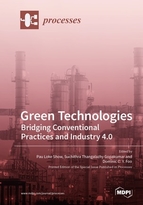Green Technologies: Bridging Conventional Practices and Industry 4.0
A special issue of Processes (ISSN 2227-9717). This special issue belongs to the section "Environmental and Green Processes".
Deadline for manuscript submissions: closed (31 March 2020) | Viewed by 125398
Special Issue Editors
Interests: process design, integration and optimisation; waste minimization; carbon emission reduction
Special Issues, Collections and Topics in MDPI journals
Interests: biotechnology; bioprocess; bioengineering
Special Issues, Collections and Topics in MDPI journals
Interests: fast pyrolysis; torrefaction; hydrothermal carbonization; bio-oil upgrading; extraction of chemicals
Special Issues, Collections and Topics in MDPI journals
Special Issue Information
Dear Colleagues,
Green technologies have been globally accepted as efficient and sustainable techniques for the utilization of natural resources. Currently, Industry 4.0, which is also called a “smart industry”, aims for the integration of cyber and physical systems to minimize waste and maximize productivity. Therefore, green technologies can be identified as key components in Industry 4.0. The scope of this Special Issue is to address how conventional green technologies can be part of smart industries by minimizing waste, maximizing productivity, optimizing the supply chain, or by additive manufacturing (3D printing). This theme is focusing on the scope and challenges of integrating current environmental technologies in future industries.
This Special Issue, Green Technologies: Bridging Conventional Practices and Industry 4.0, aims to incorporate the advances in green technologies to cyber-based industries. Topics include, but are not limited to, the following:
- Development of new disease-specific models to guide therapy;
- 3D printing
- Air pollution monitoring and control
- Carbon emission reduction
- Computational tools for environmental applications
- Energy and environmental policy
- Environmental monitoring, assessment and management
- Industry 4.0
- Process system engineering
- Renewable energy
- Solid/biomass waste treatment, management, and recycling
- Waste minimisation
Assoc. Prof. Dr. Show Pau Loke
Assoc. Prof. Dr. Suchithra Thangalazhy Gopakumar
Guest Editors
Manuscript Submission Information
Manuscripts should be submitted online at www.mdpi.com by registering and logging in to this website. Once you are registered, click here to go to the submission form. Manuscripts can be submitted until the deadline. All submissions that pass pre-check are peer-reviewed. Accepted papers will be published continuously in the journal (as soon as accepted) and will be listed together on the special issue website. Research articles, review articles as well as short communications are invited. For planned papers, a title and short abstract (about 100 words) can be sent to the Editorial Office for announcement on this website.
Submitted manuscripts should not have been published previously, nor be under consideration for publication elsewhere (except conference proceedings papers). All manuscripts are thoroughly refereed through a single-blind peer-review process. A guide for authors and other relevant information for submission of manuscripts is available on the Instructions for Authors page. Processes is an international peer-reviewed open access monthly journal published by MDPI.
Please visit the Instructions for Authors page before submitting a manuscript. The Article Processing Charge (APC) for publication in this open access journal is 2400 CHF (Swiss Francs). Submitted papers should be well formatted and use good English. Authors may use MDPI's English editing service prior to publication or during author revisions.
Keywords
- data analysis
- environmental technologies
- energy
- modelling
- process systems








